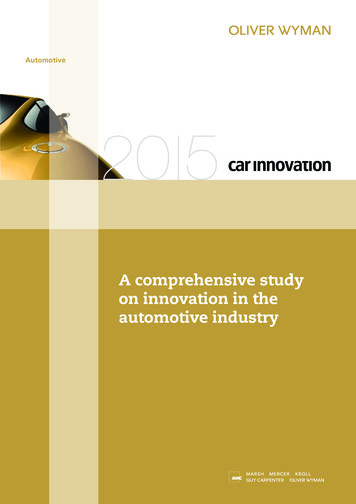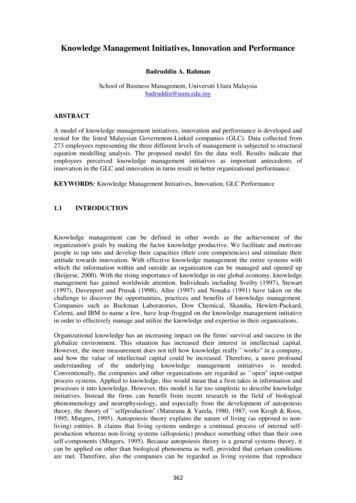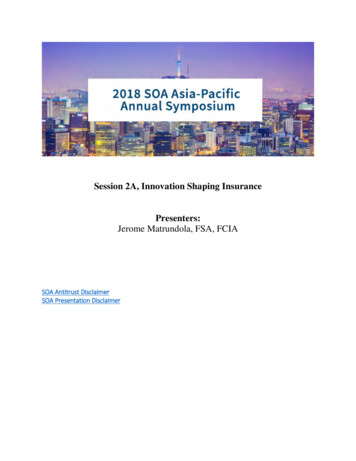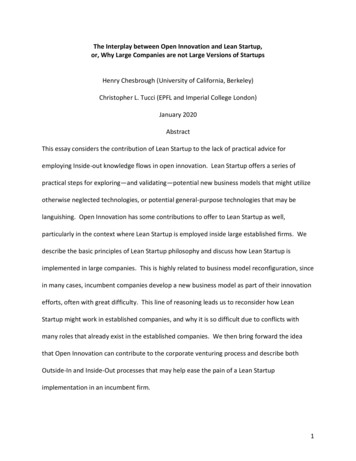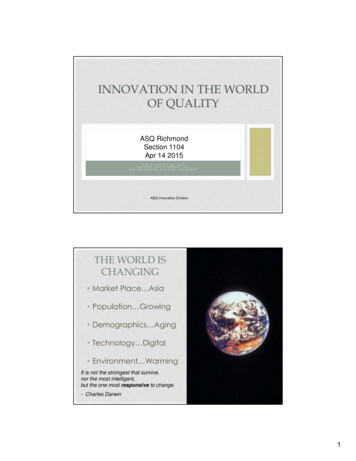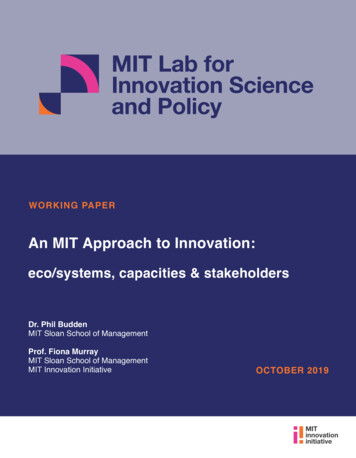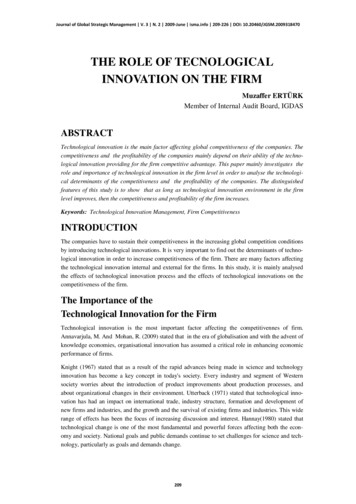
Transcription
Journal of Global Strategic Management V. 3 N. 2 2009-June isma.info 209-226 DOI: 10.20460/JGSM.2009318470THE ROLE OF TECNOLOGICALINNOVATION ON THE FIRMMuzaffer ERTÜRKMember of Internal Audit Board, IGDASABSTRACTTechnological innovation is the main factor affecting global competitiveness of the companies. Thecompetitiveness and the profitability of the companies mainly depend on their ability of the technological innovation providing for the firm competitive advantage. This paper mainly investigates therole and importance of technological innovation in the firm level in order to analyse the technological determinants of the competitiveness and the profitability of the companies. The distinguishedfeatures of this study is to show that as long as technological innovation environment in the firmlevel improves, then the competitiveness and profitability of the firm increases.Keywords: Technological Innovation Management, Firm CompetitivenessINTRODUCTIONThe companies have to sustain their competitiveness in the increasing global competition conditionsby introducing technological innovations. It is very important to find out the determinants of technological innovation in order to increase competitiveness of the firm. There are many factors affectingthe technological innovation internal and external for the firms. In this study, it is mainly analysedthe effects of technological innovation process and the effects of technological innovations on thecompetitiveness of the firm.The Importance of theTechnological Innovation for the FirmTechnological innovation is the most important factor affecting the competitivennes of firm.Annavarjula, M. And Mohan, R. (2009) stated that in the era of globalisation and with the advent ofknowledge economies, organisational innovation has assumed a critical role in enhancing economicperformance of firms.Knight (1967) stated that as a result of the rapid advances being made in science and technologyinnovation has become a key concept in today's society. Every industry and segment of Westernsociety worries about the introduction of product improvements about production processes, andabout organizational changes in their environment. Utterback (1971) stated that technological innovation has had an impact on international trade, industry structure, formation and development ofnew firms and industries, and the growth and the survival of existing firms and industries. This widerange of effects has been the focus of increasing discussion and interest. Hannay(1980) stated thattechnological change is one of the most fundamental and powerful forces affecting both the economy and society. National goals and public demands continue to set challenges for science and technology, particularly as goals and demands change.209
Journal of Global Strategic Management V. 3 N. 2 2009-June isma.info 209-226 DOI: 10.20460/JGSM.2009318470Damanpour, F., Bierly, Paul E. and Santoro, Michael D. (2009) stated that a firm’s ability to acquireand exploit external knowledge is often critical to achieving and sustaining a competitive advantage.Their results show that predictors of exploration and exploitation of the application of externalknowledge differ. Surprisingly, technological relatedness, -a common measure of absorptivecapacity,- is negatively associated with the application of external knowledge to explorativeinnovations, indicating that knowledge from more distant sources is applied more to exploration.Their results also indicate that the effects of two external learning capabilities (prior experience withURCs and technological capability) on knowledge application are moderated in such a way by thetacitness of the knowledge transferred that experience is a stronger predictor when the knowledge ismore explicit and technological capability is a stronger predictor when the knowledge is more tacit.Huergo, Elena. (2006) stated that the determinants and the effects of successful innovations havebecome of great interest in recent years. This interest has been stimulated by two factors: the common perception of innovation as a basic element for economic growth and for the improvement ofcompetitiveness in markets becoming increasingly global; and the increase of liberalization and reform of some industries that traditionally have been “public monopolies,” like telecommunicationsand transport. This process, closely associated with technological change has promoted greater competition in these markets.Narayanan (2001:121) stated that primary objective of technology management should be the creation of value for a firm. Value creation is tied to the competitive advantages that a firm can create inthe marketplace or more precisely in the firm’s competitive domains. Figure-1 shows the relationship between the technology and competitive advantage. Technology leads to both competitive dynamics and competitive advantage which leads to the value creation.CompetitiveDynamicsAs the technology changes, new technologies abolish the old ones. Schilling (2008) stated that boththe rate of a technology’s performance improvement and the rate at which the technology is adoptedin the marketplace repeatedly have been shown to conform to an S-Shape curve. Many technologiesexhibit an S-Curve in their performance improvement over their lifetimes. When a technology’s210
Journal of Global Strategic Management V. 3 N. 2 2009-June isma.info 209-226 DOI: 10.20460/JGSM.2009318470performance is plotted against the amount of effort and money invested in the technology, ittypically shows slow initial improvement, and then followed by an accelerated improvement, thendiminishing improvement. Performance improvement in the early stages of a technology is slowbecause the fundamental base of the technology are poorly understood. Figure-2 shows theTechnology S-Curves, presenting that new technologies may have different characteristics, its effectson the old technologies and performance. In the early stages, efforts invested in a new technologymay reap lower returns than efforts invested in the current technology, and firms are often reluctantto switch. However, if the disruptive technology has a steeper S-Curve (technology-2 in figure-2) oran s-curve that increases to a higher performance limit ( technology-3 in figure-2), there may come atime when the returns to the effort invested in the new technology are much higher than the effortinvested in the incumbent technology. New firms entering the industry are likely to choose thedisruptive technology, and incumbent firms face the difficult choice of trying to extend the life oftheir current technology or investing in switching to the new technology. If the disruptive technologyhas much greater performance potential for a given amount of effort, in the long run it is likely todisplace the incumbent technology, but the rate at which it does so can vary significantly.Figure- 2 Technology S-Curves- Introduction Of Discontinuous ology-1EffortSource: Schilling, M. A., Strategic Management Of Technological Innovation, McGraw-Hill, Irvin, USA, 2008, p.50Technological change deeply affects the strategic investments decisions of the firms because of thecompetitiveness. Firms have to forecast technological change direction in order to allocate its resources to the investments which provide maximum profit. Annavarjula, M. And Mohan, R. (2009)utilised a broader definition of organisational innovation capability that includes the generation,dissemination and strength of innovative activity in a firm.Technological Innovation and TypesTechnological innovation basically presents the significantly improved technological novelty/changeproviding economic advantages for the firms. Technological innovation captures both technologicalinvention and successful commercialization.211
Journal of Global Strategic Management V. 3 N. 2 2009-June isma.info 209-226 DOI: 10.20460/JGSM.2009318470Utterback (1971) stated that the invention is an original solution resulting from the synthesis of information about a need or want and information about the technical means with which the need orwant may be met. An invention must be followed by entrepreneurial action before it has significancein economic terms. Thus, innovation will be defined to refer to an invention which has reached market introduction in the case of a new product, or first use in a production process, in the case of aprocess innovation. The key idea here is, that first use, does not preclude consideration of adoptedideas which are new in a particular market or application, nor does it provide a measure of the economic significance of an innovation. It simply requires that an idea has been carried far enough tobegin to have an economic impact.OECD and EuroStat (2005) stated that an innovation is the implementation of a new or significantlyimproved product (good or service), or process, a new marketing method, or a new organisationalmethod inbusiness practices, workplace organisation or external relations. The minimumrequirement for an innovation is that the product, process, marketing method or organisationalmethod must be new (or significantly improved)to the firm. This includes products, processes andmethods that firms are the first to develop and those that have been adopted from other firms ororganisations.Although technological innovation is so important for the firms’ competitiveness in the global competitive environment, it is not easy to improve technological innovation for the firms. Technologicalinnovation results from many efforts on R&D, technological development processes and depends onthe many factors affecting internal and external to the firms. OECD and EuroStat (1997) stated that itis important to distinguish between internal and external (or endogenous and exogenous) sources ofchange. Internally, interest is likely to focus on the role – or roles – of the R&D department, and theinvolvement of all parts of the firm, particularly the marketing side, in decisions to innovate and oninnovation activities. Externally, the focus will be on public research institutions as sources oftechnical information, and on inter-firm or inter-industry technology flows. Consideration of externalsources of innovation or technological change ought logically to extend to international sources oftechnology, and be structured in such a way as to throw light on some of the unresolved problemswith the technology balance of payments.Utterback (1971) stated that the process of innovation will be considered as occurring in three overlapping phases or subprocesses, the first two of which culminate in an invention, and the last ofwhich results in an innovation. These phases are: (1) idea generation, (2) problem solving, and (3)implementation, possibly followed by diffusion. The idea generation phase results in origination of adesign concept or technical proposal, perhaps via synthesis of several pieces of existing information.The problem-solving phase results in an original technical solution, or an invention. The implementation phase results in market introduction of the original solution making it an innovation as definedabove. Diffusion is the mechanism of communication and increasing use through which an innovation comes to have a significant economic impact.OECD and EuroStat (2005) stated that the work of Joseph Schumpeter has greatly influencedtheories of innovation. He argued that economic development is driven by innovation through adynamic process in which new technologies replace the old, a process he labelled “creativedestruction”. In Schumpeter’s view, “radical” innovations create major disruptive changes, whereas“incremental” innovations continuously advance the process of change. Schumpeter (1934) proposeda list of five types of innovations: i) Introduction of new products, ii) Introduction of new methods of212
Journal of Global Strategic Management V. 3 N. 2 2009-June isma.info 209-226 DOI: 10.20460/JGSM.2009318470production, iii) Opening of new markets, iv) Development of new sources of supply for rawmaterials or other inputs, v) Creation of new market structures in an industry.OECD and EuroStat (2005) stated that four types of innovations are distinguished: productinnovations, process innovations, marketing innovations and organisational innovations. Productinnovations and process innovations are closely related to the concept of technological productinnovation and technological process innovation. Marketing innovations and organisationalinnovations broaden the range of innovations.Table-1 shows the classification of innovations; Narayanan (2001) stated that four major types ofinnovations in Table-1, incremental, modular, architectural and radical. Incremental innovationrepresents minor improvement or changes to the elements of an existing product or organizationaltechnologies and practices. Modular innovation refers to significant changes in elements of products,organizational practices, and technologies without significant changes to the existing configurationof the elements. Architectural innovations use existing organizational practices and technologies butreconfigure them in new or different ways. Radical innovations represent revolutionary changes thatrequire clear departures from existing organizational practices and technologies. Both process andproduct technologies can be classified into the four types of innovation enumerated in Table-1 andTable-2.Table- 1 Classification Of InnovationsCharacteristicsOf Elements:Component hangeModularRadicalExistingNovelCharacteristics Of Linkage Among Elements :Component ConfigurationSource: Narayanan, V.K. Management Technology And Innovation For Competitive Advantage,UNCHANGEDCHANGEDEFFECT ON COMPENENTCONFIGURATIONTable- 2 Classification Of Innovations ForProducts, Processes And ServicesEffect On Component KnowledgeReinforcedOverturnedIncremental InnovationsModular innovations:Product Technology:Product technology :486 MicroprocessorsDigital phoneProcess technology :Process technology :Continuous ImprovementQuality CirclesArchitectural innovation :Radical Innovations:Product technology :Product technologies:Plain paper copiersVCRProcess technology:Process technologies:Just-in-time inventoriesRobotics in ManufacturingSource: Narayanan, V.K. Management Technology And Innovation For Competitive Advantage, Prentice Hal, USA,2001, p.74213
Journal of Global Strategic Management V. 3 N. 2 2009-June isma.info 209-226 DOI: 10.20460/JGSM.2009318470Fariborz, D.Richard M. W, Claudia N.A. (2009) stated that the impact of innovation onorganizational performance depends on compositions of innovation types over time. They suggestedthat focus on adopting a specific type of innovation every year is detrimental, consistency inadopting the same composition of innovation types over the years has no effect, and divergence fromthe industry norm in adopting innovation types could possibly be beneficial to organizationalperformance.Technological Innovation Dynamics and ManagementTechnological innovations have important dynamics to arise for the firms. It is important to applyimportant policies to trigger for the technological innovation both in firm and economy level.Edquist, Charles and Leif Hommen (1999) claimed that innovation policies can be classified asdemand-side oriented or supply-side oriented. Similarly, theories of the innovation process can beclassified as being linear or systems-oriented. There are important parallels and logical connectionsto be drawn between these two classifications. On the one hand, linear views of the innovationprocess support a supply-side orientation in innovation policies. On the other hand, systemsperspectives on innovation yield a much more fruitful perspective on the demand side, in terms ofboth theoretical and policy relevance. Huergo, Elena, (2006) stated that the planning and monitoringof the innovation process and the hiring of personnel with special skills for technological activitiesare significant sources of innovation, although with important differences regarding the type ofinnovation (process versus product). In addition, the evidence suggests that large firms’ advantagesfor the generation of product innovations are related to a different use and effectiveness oftechnological management mechanisms.Figure-3 shows the interactive model of innovation capturing both market pull and technology push.According to the Figure-3, innovation results from both market pull capturing needs of the societyand market. On the other hand technology push capturres the latest advances in science andtechnology.Figure- 3 Interactive Model Of InnovationLatest Science and technologyTECHNOLOGYPUSHAdvances in societyIDEACommercialproductR&DMARKETPULLNeeds of societyAnd the market placeSource: Trott . P. “ Innovation And Market Research “ in The International Handbook On Innovation, Editor, Shavinina, Larisa, Pergamon, 2003, s.837214
Journal of Global Strategic Management V. 3 N. 2 2009-June isma.info 209-226 DOI: 10.20460/JGSM.2009318470OECD and EuroStat (1997) stated that the technological capability of a firm depends on the structureof its labour force and facilities (skills, departments), its financial structure, its strategy on markets,competitors, alliances with other firms or with universities, and above all its internal organisation.Many of these aspects are complementary. A particular skill structure will go hand in hand with aparticular type of strategy, financial structure and so on.Galende and Fuente (2003) in Table-3 emphasized that a summary of the main theoretical argumentsand empirical studies concerning the effect of internal factors on the innovative activity. It is easy tosee that the traditional course of theoretical argument and of empirical contrast deals with the directimpact of the internal factors on a firm’s innovative result.Table- 3 Internal Factors And InnovationFactorSizeTheoreticalEmpirical StudiesLarge: Economies,Risk, Market,AppropriationLarge: Horowitz (1962), Lunn And Martin (1986), Braga And Willmore(1991), Henderson And Cockburn (1996), Gumbau (1997), ArundelSmall: Flexibility,Communication,Specialisation,Informal ControlsSmall: Worley (1961), Mansfield (1964), Grabowski (1968), Adams(1970), Loeb And Lin (1977), Scherer (1984), Acs And Audretsch(1988), Graves And Langowitz (1993)Intermediate: Scherer (1965b), Mansfield Et Al. (1971), Smith(1974), Kumar And Saqib (1996) Both: Rothwell (1986), Pavitt EtNegative: Specificity,Risk,InformationAsymmetriesNegative: Grabowski (1968), Elliott (1971), Branch (1974), KamienAnd Schwartz (1978), Hall (1990), Long And Ravenscraft (1993),Giudici And Paleari (2000)Human ResourcesPositive: Qualification,Positive: Galende And Su Arez (1998, 1999), Mart Inez-Ros AndSalas (1999)Commercial ResourcesPositive: nPositive: Freeman (1973), Rothwell Et Al. (1974), Doi (1985), LunnAnd Martin (1986), Gumbau (1997)Organisational gration,Positive: Freeman (1973), Rothwell Et Al. (1974), Rothwell (1986),Kleinknecht And Reijnen (1992), Busom (1993), Bughin AndJacques (1994), Kumar And Saqib (1996), Gumbau (1997), Kuemmerle (1998)DiversificationNegative: Formal AndFinancialControlsPositive: Mceachern And Romeo (1978), Link (1982), Chen (1996)Negative: Hoskisson And Hitt (1988), Baysinger And Hoskisson(1989), Hoskisson And Johnson (1992), Hoskisson Et Al. ,MarketPositive: Meisel And Lin (1983), Lunn And Martin (1986), BragaAnd Willmore (1991), Busom (1991), Labeaga And Mart Inez-Ros(1994), Kumar and Saqib (1996), Galende and Su arez (1998, 1999)DebtSource : Galende A, Jesús, Juan Manuel De La Fuente, “Internal Factors Determining A Firm’s Innovative Behaviour”Research Policy 32 (2003) 715–736Galende and Fuente (2003) modelled internal determinants of the innovative process in Figure-4.They emphasized the confirmed hypotheses together with the innovative characteristic that has beenused as a dependent variable. These relationships allow the following to be confirmed: The companies that opt for an internal method of technology generation have greater organisational resources.215
Journal of Global Strategic Management V. 3 N. 2 2009-June isma.info 209-226 DOI: 10.20460/JGSM.2009318470The internal sources of scientific and technological information are used by firms with greater organisational resources. These resources also induce an important use of external sources of information.The accumulative nature of the innovative activity, determined by the innovative age of the company, is increased by the firm’s size, by the possession of greater organisational resources and by thefirm’s level of internationalisation. The objectives for the innovation related to the entry into newmarkets is more frequent in internationalised firms. Companies that invest a greater proportion oftheir R&D activities in basic and applied research possess greater organisational resources. The generation of a greater proportion of product innovations is the characteristic of the companies with highcommercial resources, and the intense development of incremental innovations is carried out by debtfinancing firms.Figure- 4 Internal Determinants Of The Innovative ProcessSource : Galende A, Jesús, Juan Manuel De La Fuente, “Internal Factors Determining A Firm’s InnovativeBehaviour” Research Policy 32 (2003) 715–736Technological innovations, therefore technological management is very important for the firms. Narayanan (2001:8) stated that management of technology links engineering, science and managementdisciplines to plan, to develop, and to implement technological capabilities for the aim of shapingand accomplishing the strategic and operational goals of an organization. Three important dimensions of the definition are as that;1-The emphasis in the management of technology is to accomplish the goals of an organization.216
Journal of Global Strategic Management V. 3 N. 2 2009-June isma.info 209-226 DOI: 10.20460/JGSM.20093184702-Technology management focuses on the development of technological capability and its implementations or deployment in products and processes.3-Technology management within corporations is linked to other management activities. Narayanan(2008:8) defined that management of technology (see in Figure-5) focuses on the principles of strategy and organization involved in technology choices, guided by the purpose of creating value for theinvestors. Narayanan stated that all management, including the management of technology start withsome statement of a firm’s identity and purpose. The answer to the question what is our business?Has been provided by two complementary perspectives: market based and resource based.Figure- 5 Management of chnologyTechnologySource: Narayanan, V.K. Management Technology And Innovation For Competitive Advantage, Prentice Hal, USA, 2001, p.9It is important for the firms to analyse the relationship among the product system, business system,technology system and application system in order to understand the relationship among profitability, sales&market and technology push&market push conditions. Figure-6 shows product system as alinking system. The relationships among these systems deeply affect the profitability and competitiveness of the firms.One of the most important factors affecting firms’ competitiveness is technological new productdevelopment, in other words, technological innovations. Technological innovations are veryimportant for the firms in order to increase the profitability and the competitiveness of the firms.Technological innovation development models vary from linear innovation models to cyclicalinnovation models. Betz (1993:25) stated that in contrast to the logic of a linear radical innovationprocess; proceeding from science to technology.These models present the management of technological change dynamics to increase thecompetitiveness of the firm. Figure-7 shows cyclical innovation process. Betz (1993:25) stated thatin contrast to the logic of a linear radical innovation process proceeding from science to technology,the logic of cyclic incremental innovation processes differs substantially, cyclical around technologyand product. The logic of cyclic innovation process consists of five central concepts:1– Technology anticipation,2– Technology acquisition,217
Journal of Global Strategic Management V. 3 N. 2 2009-June isma.info 209-226 DOI: 10.20460/JGSM.20093184703- Technology implementation,4- Technology exploitation,5- Technology stimulation. It is necessary to first anticipate technological change so that one hastime to prepare and take advantage of it. Next, it is necessary to acquire new technology for use bythe firm. Then new technology can be embedded into new products, processes or services. The nextlogical step is to commercially exploit the new technology through new product introductions andaggressive pricing/quality strategies. Customers’ subsequent experiences with the new productssuggest new needs and stimulate requirements for more new technology. The cyclic innovationprocess is driven by incremental improvements to technology that periodically improves the value ofproducts to customers. For firms, these steps form a kind of circular pattern in the technical andbusiness activities of the firm.Betz (1993:26) stated that the linear radical innovation process provides dramatic, discontinuousimpacts on the economy (enabling the creation of new markets or the entry of existing markets),whereas the cyclic incremental innovation process provides quiet, steady, continuous impacts on theeconomy (eventually enabling the capture and domination of markets). Figure-8 shows integrationcyclical innovation with linear innovation in next-generation technology product. In the cyclical innovation process, the stimulation of need for new technology fosters the vision of a next-generationtechnology in the linear innovation process. The technical feasibility prototype in the linear innovation process provides the grounds for anticipation of new technology in the cyclic innovation process. The functional prototype in the linear innovation process provides the information for acquiringnew technology in the cyclic innovation process. The implementation phase in the cyclic innovationprocess designs the engineering prototype in the linear innovation process (which with concurrentengineering practice also fosters the manufacturing prototypes and pilot production). Volume pro-218
Journal of Global Strategic Management V. 3 N. 2 2009-June isma.info 209-226 DOI: 10.20460/JGSM.2009318470duction in the linear innovation process of the next-generation product provides the opportunity forexploitation of the new technology in the cyclic innovation process. By establishing “technical feasibility” the new linear innovation process can provide anticipation to the cyclic innovation process forthe new generation of a technology.Narayanan (2001:255) stated that technology strategy is the revealed pattern in the technologychoices of firms. The choices involve the commitment of resources for the appropriation, maintenance, deployment, and abandonment of technology capabilities. These technology choices determine the character and extent of the firms’ principal technical capabilities and the set of availableproduct and process platforms. The important points of the definition are as follows:1-Technology strategy focuses on the kinds of technologies that a firm selects for acquisition, development, deployment or deinvestment.2-Commitments surrounding technology selection define technology strategies.3-Technology strategies are not confined to high-technology industries. Even a capacity-driven industry or a customer-driven industry requires a technology strategy.4-finally, technology strategies embrace both the hardware and software elements of a technology.Although the term technology is often associated with hardware elements, the preceding definitionof technology strategy includes both software and hardware elements. On the other hand, Figure-9shows the central principles of technology choices including firms’ objective, drivers, decision criteria and choice outcomes.219
Journal of Global Strategic Management V. 3 N. 2 2009-June isma.info 209-226 DOI: 10.20460/JGSM.2009318470220
Journal of Global Strategic Management V. 3 N. 2 2009-June isma.info 209-226 DOI: 10.20460/JGSM.2009318470Narayanan (2001:255) stated that specific technology choices exhibit a pattern over time, these patterns may be classified two dimensions, scope and leadership. Based on the two dimensions fourbroad types of technology strategies are available. These are as follows (see in Table-4):Technology leadership strategy consist of establishing and maintaining through both technologydevelopment and deployment of a preeminent position in the competitive domain in all the technologies for a dominant market position. Technology is the primary instrument for creating and maintaining competitive advantage for these firms.Niche strategy consists of focusing on a limited number of critical technologies to seek leadership.Technology development is selective, and deployment is oriented toward exploiting the technological strength of the firm in selected technologies to create competitive advantage.Follower strategy consists of maintaining technological adequacy in a broad set of technologies. Thisstrategy is focused on deployment, avoiding the risks of basic research. For these firms, technologyis not their primary instrument
Technological Innovation and Types Technological innovation basically presents the significantly improved technological novelty/change providing economic advantages for the firms. Technological innovation captures both technological invention and successful commercialization. Source: Schilling, M. A.,



